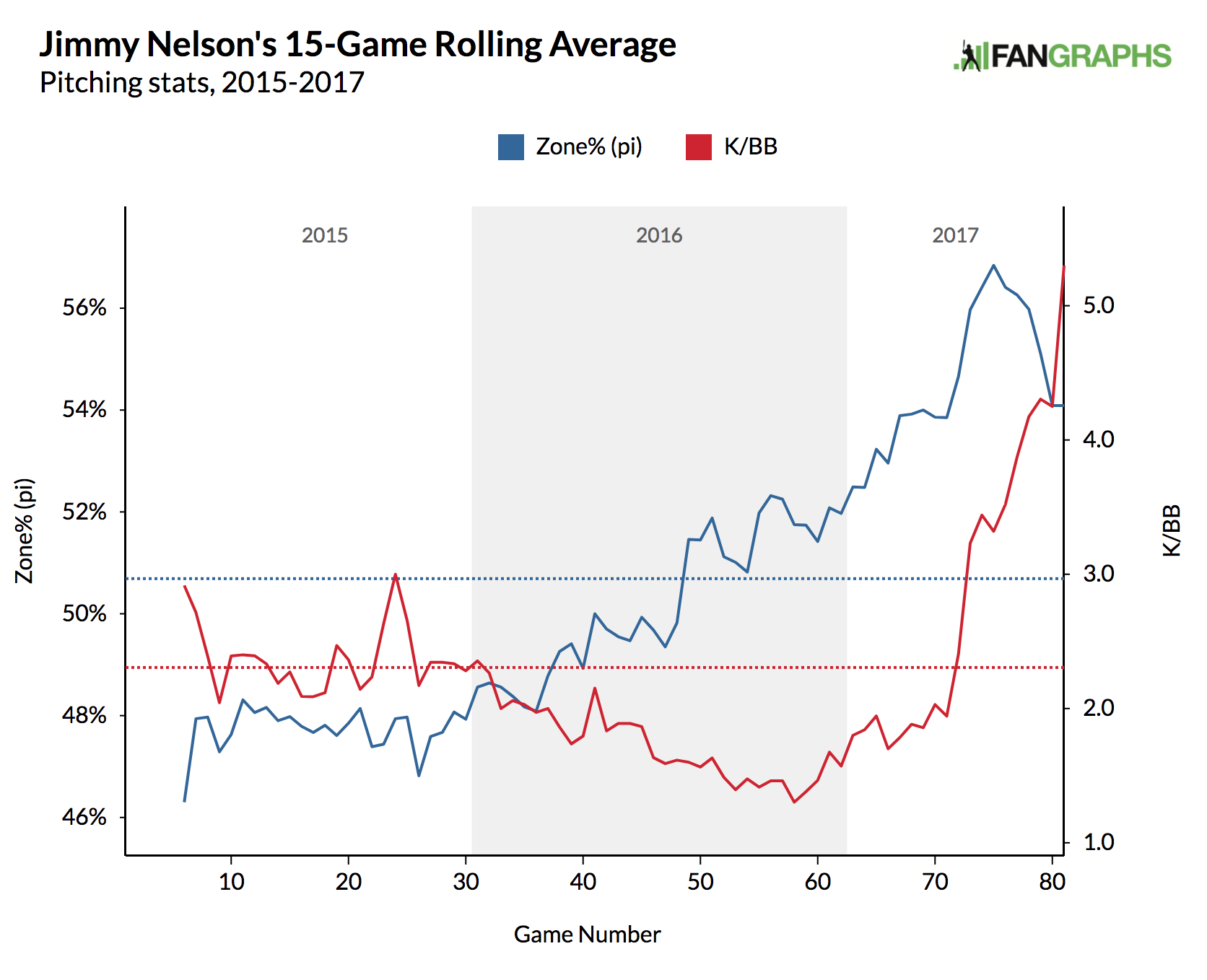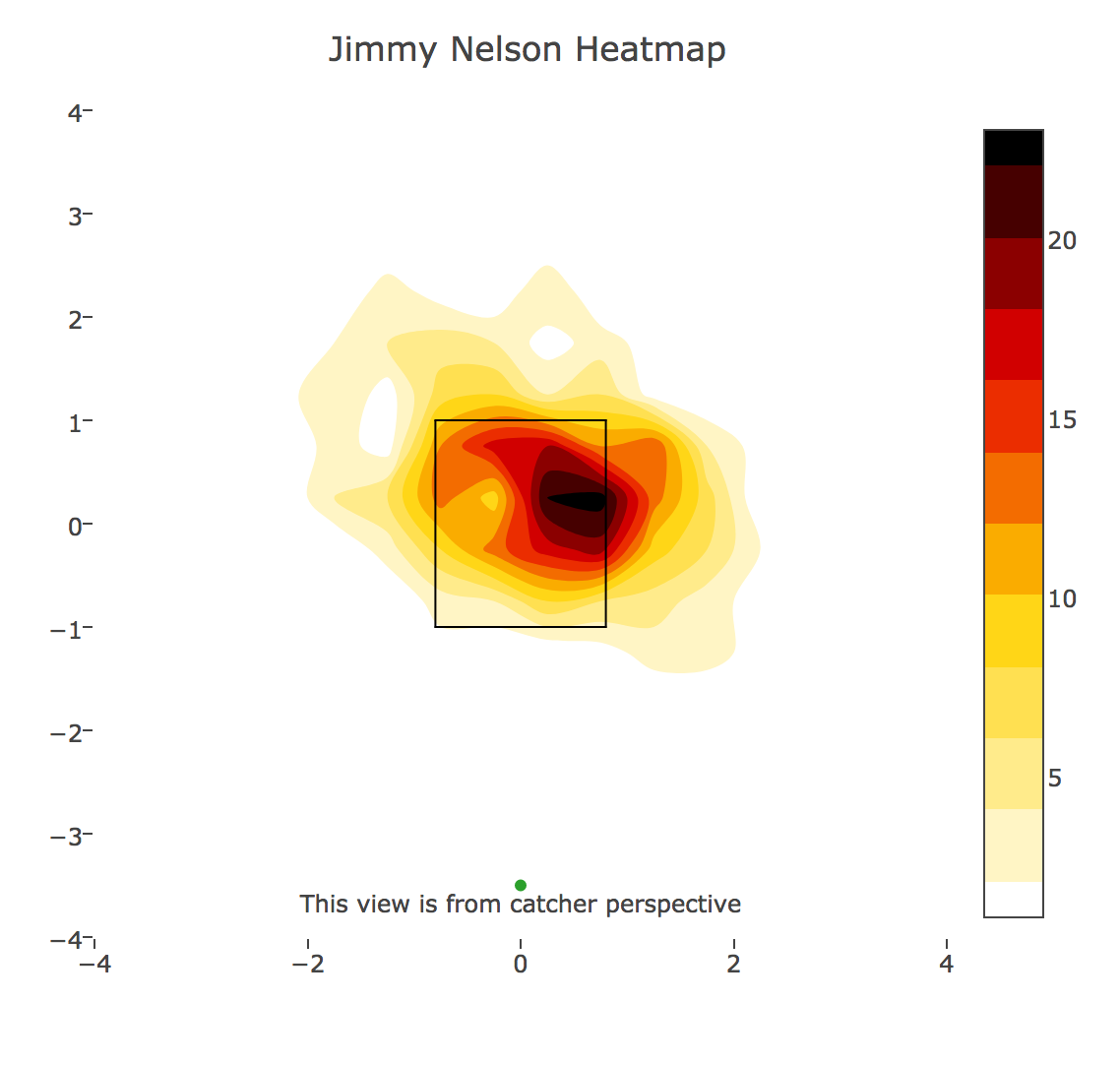Ace and Kinesiologist, Jimmy Nelson
PITTSBURGH — The Brewers are probably the greatest surprise among the league’s 30 teams this season. The club remains atop the NL Central for a number of reasons — the triumphant return of Eric Thames to the States, a breakout year from Travis Shaw. Among Milwaukee’s 25-man roster, however, the player most directly responsible for the team’s success is probably Jimmy Nelson, who ranks 10th among all pitchers with 3.1 WAR. Nelson entered the season with four career wins above replacement covering 440 innings.
Earlier this year FanGraphs’ Jeff Sullivan said the Brewers might have serendipitously found an ace in Nelson. Sullivan noted Nelson was among the game’s biggest improvers by strikeout- and walk-rate differential (K-BB%), particularly against left-handed hitters.
As is demonstrated in the following chart, Nelson’s zone rate and K-BB% keep on trending in the right direction.

That’s the trajectory to ace-hood if he can sustain this new level, and there is reason to believe he can sustain this new level — or, at the very least, to believe he’s reached a new level — because there’s a new process behind the results.
While Nelson has lowered and extended out his arm slot a bit, recording a -2.00 foot horizontal release point this season compared to -1.72 last season, he said that it isn’t the result of a conscious change or act. What he has intentionally done is change the lower half of his delivery. By watching video from last season, Nelson and pitching coach Derek Johnson noticed that Nelson was closing off his delivery in 2016. His front foot was landing slightly off line and toward third base. (Such evaluation is yet another argument for the use of center-field TV cameras set directly in line with and behind the pitching mound.)
“I would go to throw and it would seem like it [Nelson’s back leg] was along for the ride,” Nelson told FanGraphs. “I was not using it. It looked stiff. Not a fluid delivery…
“[This season], my direction plays a lot better, so I can command both sides. The reason I am getting on a better line is I am driving off my back leg better, which is helping me get out [arm extension and release point] there a little further… I was telling D.J., I think the arm slot might seem like it’s lower because I’m staying on my legs better, using my legs better, especially my back leg.”
Not only is Nelson throwing more pitches in the zone, he also appears better able to throw more consistently to the glove and arm sides of the plate.
Consider Nelson’s fastball location in the 50-50 east, west, and south regions of Baseball Savant’s detailed search from 2016:

And now from 2017:

Here’s Nelson’s fastball locations against lefties in 2016:

And 2017 via Baseball Savant:

Nelson has always been interested in what he describes as the “kinetic” aspects of the delivery. His mother — who played basketball at Florida State — is a physical therapist, and he often asked her about her work.
“I grew up around it,” Nelson said.
Nelson studied kinesiology at the University of Alabama, out of which he was selected in the second round of the 2010 draft by the Brewers. The 6-foot-5, 250-pound Nelson was drafted in part for his size. Now he’s getting that size on line on a more efficient, direct path to the plate.
“Some guys say I like it too much,” said Nelson of kinesiology and exercise science. “I am wearing them out.”
To improve his stability and strength, Nelson spent his offseason at Tomball Sports Medicine just outside of Houston, where the staff there coordinated with the Brewers’ strength and training staff to come up with a plan to best help Nelson.
“Lot of strength and balance work, a lot of lower-body stability,” Nelson said.
Nelson said he would go through drills and often be barefoot to “strengthen little muscles in feet and my calves, which help you stabilize into the ground.” Nelson notes the delivery starts from the feet.
During the season, Nelson engages in less stretching and more activation, which is a more intense pre-game, pre-start warm-up that is designed to fires muscles that are used in the act of pitching and increase heart rate closer to competition levels.
“You just have to do different exercises to activate hamstrings and glutes, what you want to use more so than quads,” Nelson said. “We always do activation in weight room as part of warm-up routine. We went from stretching a lot to activation… [T]here is nothing else that needs to be stretched out; [muscles] needs to be turned on.”
It has all helped to give Nelson greater strength and balance in his delivery, which is allowing for more direct, efficient mechanics. His extension has improved. His average extension of 6.38 feet is above the MLB average 6.13. His perceived two-seams velocity 93.69 mph is well above the MLB average (90.88), according to MLB.com.
Consider the delivery and path of the 2017 version of Nelson against the Cardinals’ Matt Carpenter from a starter earlier this season.
Here is Carpenter, who possesses one of the game’s best batting eyes, helplessly watching a pitch graze the edge for a strikeout.
In a Carpenter’s second plate appearance of the game, he expands and waves over the top of a Nelson breaking ball.
Then compare Nelson’s delivery, particularly his lower half, from this footage from 2016:
Nelson hasn’t changed his pitch mix. He still throws his four-seam and sinker at the same rates, he still leans on a curveball and slider at roughly the same frequency. What has changed is his ability to command and harness it.
While his mechanics and routines have changed, Nelson said he has also done work from the mental side, too, what he considers a sort of dialing down in the midst of competition. He thought about how much more effective he was in bullpen sessions, when he didn’t feel like he was throwing at max effort. And he’s brought that mentality into live games.
“You’re hitting every spot and you’re like ‘Man, this is like a video game,'” Nelson said of bullpens.
And the real games have become more like video games for Nelson whose command has improved, whose delivery has become more efficient, whose K-BB% rates and production have reached ace-like levels. Nelson is an unlikely ace but the process behind the improvement suggests it is no accident or fluke.
A Cleveland native, FanGraphs writer Travis Sawchik is the author of the New York Times bestselling book, Big Data Baseball. He also contributes to The Athletic Cleveland, and has written for the Pittsburgh Tribune-Review, among other outlets. Follow him on Twitter @Travis_Sawchik.

Being able to stabilize his body through his release surely seems to be helping him. Lester kind of went through the same ordeal a few years back iirc. The Pilates routing can work for a lot of guys. Put yourself in a better position physically and allow for better a) extension and b) stabilization will lead to better control long term.